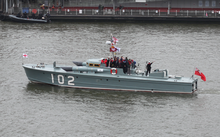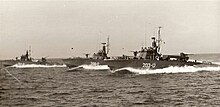
Back MTB ANG Торпеден катер Bulgarian Torpedni čamac BS Motortorpedoboot (Großbritannien) German Moottoritorpedovene Finnish Motor Torpedo Boat French Torpedni čamac Croatian Perahu motor torpedo ID Motosilurante Italian 高速魚雷艇 Japanese
This article needs additional citations for verification. (March 2013) |


A motor torpedo boat is a fast torpedo boat, especially of the mid 20th century. The motor in the designation originally referred to their use of petrol engines, typically marinised aircraft engines or their derivatives, which distinguished them from other naval craft of the era, including other torpedo boats, that used steam turbines or reciprocating steam engines. Later, diesel-powered torpedo boats appeared, in turn or retroactively referred to as "motor torpedo boats" for their internal combustion engines, as distinct from steam powered reciprocating or turbine propulsion.
Though other navies built similar petrol-powered craft, the specific designation "motor torpedo boat", abbreviated to "MTB", is generally used for craft of the Royal Navy (RN) and Royal Canadian Navy boats.
During the Second World War, the US Navy built several classes of marine V-12-powered PT boat, whose hull classification symbol "PT" stood for "patrol, torpedo", but which were grouped into motor torpedo boat squadrons.[1] German diesel-powered torpedo boats of the Second World War were called S-boote (Schnellboote, "fast boats") by the Kriegsmarine and "E-boats" by the Allies. These large craft (well over 100 ft overall) were not known as motor torpedo boats at the time, but later have been grouped with them by some. Italian MTBs of this period were known as Motoscafo Armato Silurante ("MAS boats", torpedo-armed motorboats). French MTBs were known as vedettes lance torpilles ("torpedo-launching fast boats"). Soviet MTBs were known as торпедные катеры (torpyedniye katyery; "torpedo cutters", often abbreviated as TKA). Romanian MTBs were known as vedete torpiloare ("torpedo fast boats").
The role of the motor torpedo boat has been absorbed in modern navies by the fast attack craft.
- ^ "Motor Torpedo Squadron ONE, Report for Pearl Harbor Attack, Naval History and Heritage Command". Archived from the original on 11 August 2020. Retrieved 29 February 2020.